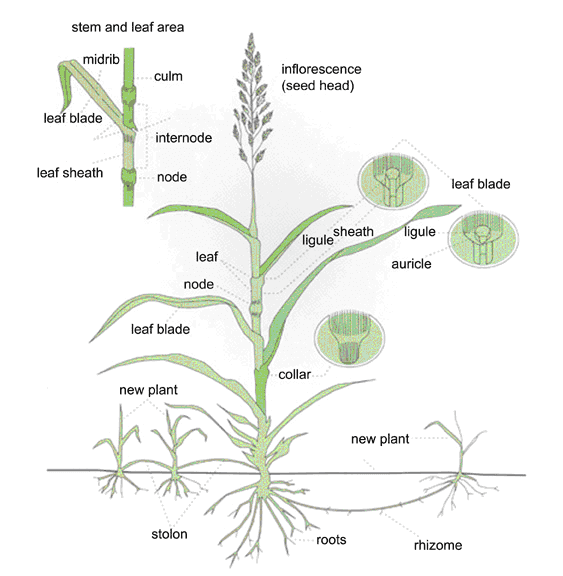In understanding the morphology of grasses, Grasses, which are a type of plant, have some specific features that help us identify and understand them better. These features are called morphological characteristics, which basically means the physical traits or structures of the grass plant. Let’s discuss a few key ones:
1. Leaf Structure: Grasses typically have long, narrow leaves with parallel veins running along the length of the leaf. The leaves usually emerge from the base of the plant, forming what is commonly known as a ‘rosette.’ This leaf structure is important for capturing sunlight efficiently, which is crucial for photosynthesis, the process by which plants make their food.
2. Stems and Nodes: The stems of grasses are usually round and hollow, and they can vary in height depending on the species. One important feature of grass stems is the presence of nodes, which are points on the stem where the leaves emerge. These nodes play a crucial role in the growth and development of the plant.
3. Root System: Grasses typically have a fibrous root system, which means that they have a network of thin roots that spread out in many directions just beneath the soil surface. This type of root system helps grasses efficiently absorb water and nutrients from the soil, making them well-adapted to various environments.
4. Inflorescence: The flowers of grasses are typically grouped together in a structure called an inflorescence. The inflorescence of grasses is often a spike-like structure called a ‘spikelet’ that contains the actual flowers. This is an important feature for the reproduction of the grass plant.
5. Adaptations to Grazing and Mowing: Many grasses have adapted to grazing and mowing by developing growing points close to the ground, allowing them to regrow quickly after being grazed or mown. This adaptation is important for their survival, especially in areas where they are often grazed by animals or used for lawn and pasture maintenance.
Understanding these morphological characteristics can help us identify different types of grasses and understand how they grow and develop. By recognizing these features, we can better appreciate the importance of grasses in various ecosystems and their significance in agriculture.
Read Also: What is Sampling Methods of Water Quality Management and Pollution Control?

The root of grasses is fibrous in structure and it occurs in tussock or bunch depending on the specie. However, some grass species such as Sorghum bicolor may have a long fibrous rooting system that could go deep into the soil in search of moisture.
The root contains small root hairs that are used for the absorption of water and minerals from the soil. Generally, the roots of grasses are shallow compared to those of legumes and shrubs. Some grasses have rhizomes (underground storage organs that assist the grass to survive harsh conditions such as drought).
The shoot of grasses is divided into two parts-the stems and the inflorescence (flower). The stem is made up of leaves, nodes, and inter-nodes. The leaves are attached to the stem at the leaf sheath (a thin leathery cover that holds the leaf).
Pasture and forage crops have unique characteristics that can easily be used to identify them in the field. These morphological differences have a direct effect on the forage yield and quality of the plants. Animals graze the leafy parts of the plants first before other parts are eaten.
This is because the leaves are more palatable and nutritious compared to the stems or branches. Studying the morphological parts of pasture and forage crops will enable us to know how to properly utilize our pasture and forage resources.
Read Also: Common Forage Crops used in Livestock Feeding
The leaves of grasses have parallel venation patterns with a central mid-rib at the center. The leaf blade is found at the edges, which could be very sharp in some species. Some hairs may be present under the leaf blade in some grass species.
The inflorescence or flower is the reproductive part of the grass. It is found at the topmost end of the plant. It is made up of spikes and spikelets. Other patterns of arrangement of flowers on the spike are possible.
It is important to note that in some grass species, there may be many stems when the grass has stolons (structures that enable the stem to extend to other parts thereby forming a network of stems).
In conclusion, pasture and forage crops have unique characteristics that can easily be used to identify them in the field. These morphological differences have a direct effect on the forage yield and quality of the plants. Animals graze the leafy parts of the plants first before other parts are eaten.
This is because the leaves are more palatable and nutritious compared to the stems or branches. Studying the morphological parts of pasture and forage crops will enable us to know how to properly utilize our pasture and forage resources.
Grasses are morphologically divided into fibrous roots and shoots (leaves, stems, and flowers). Legumes are divided into roots, branches, leaves, and flowers
Shrubs are like forage legumes except that they have more woody stems, leaves, and flowers and their height is up to 4 meters.
